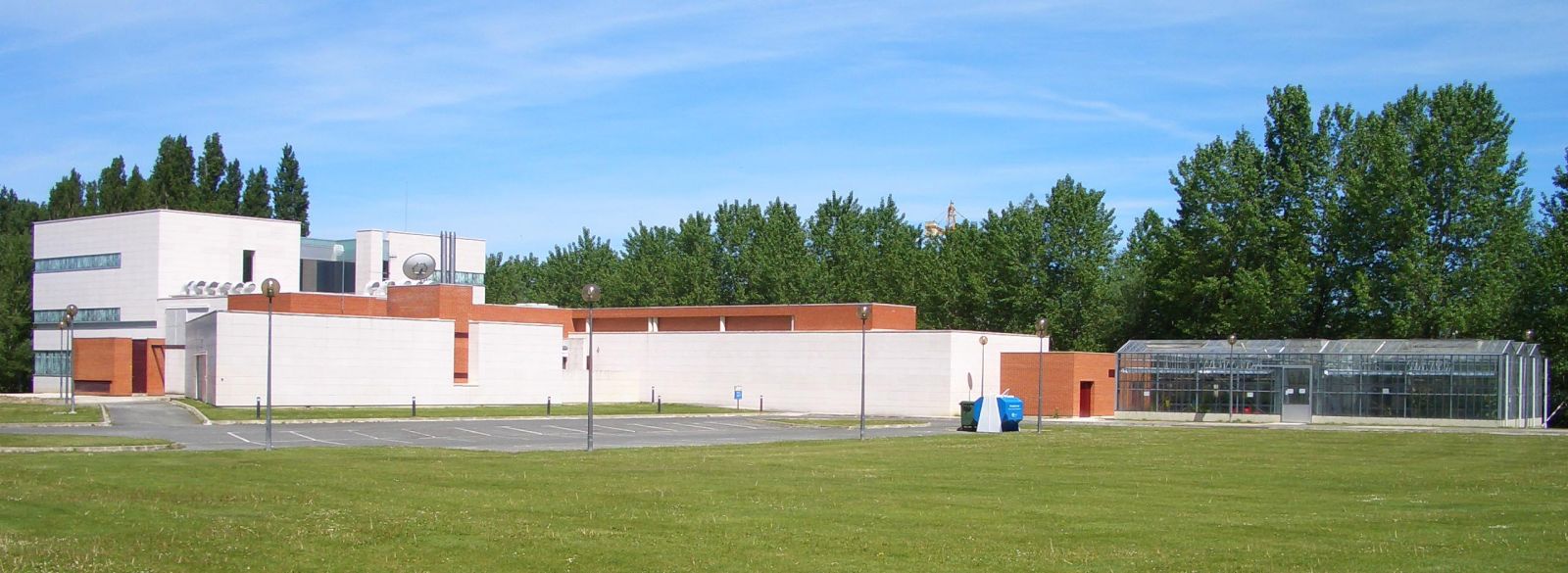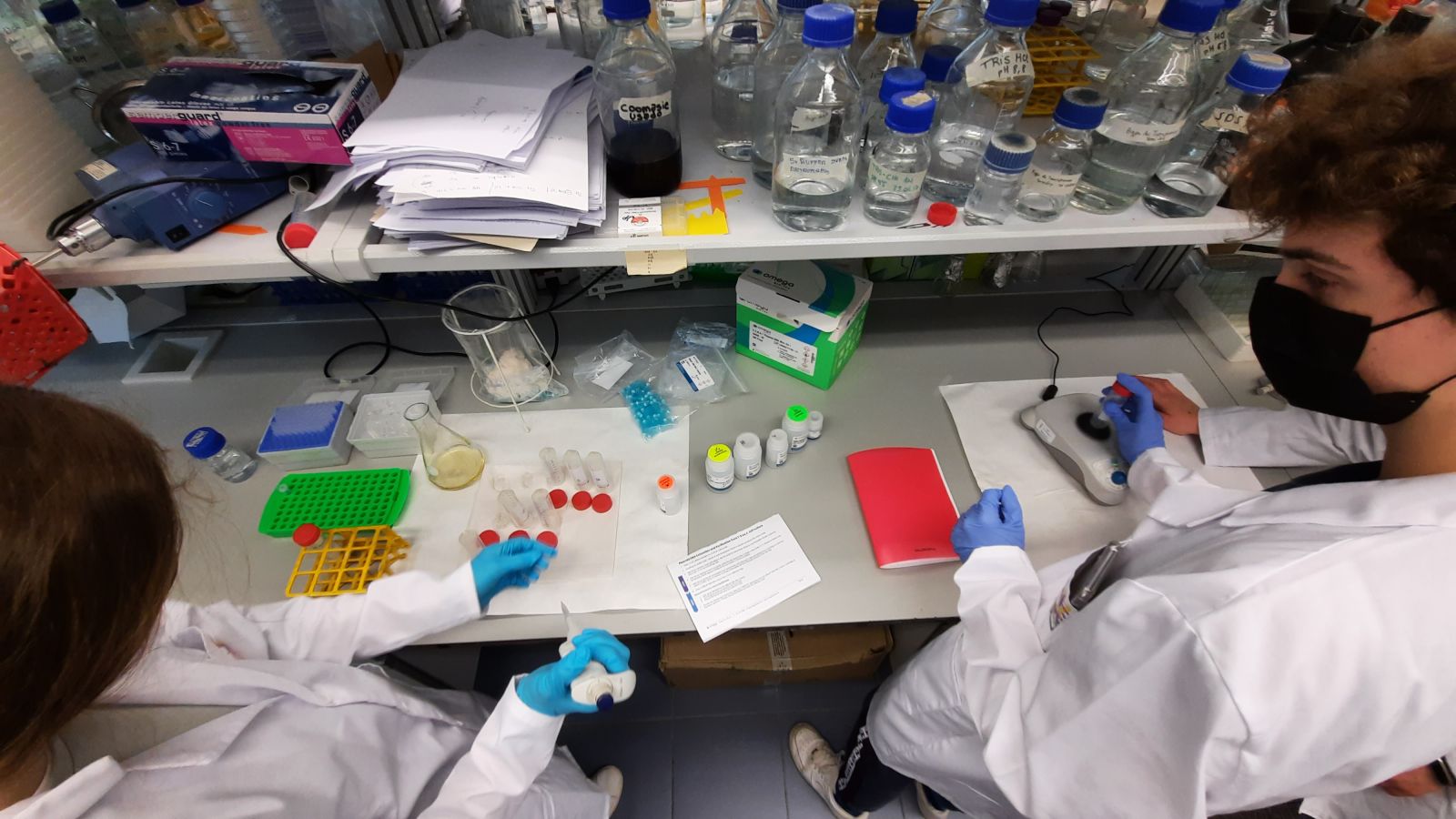
Apirila ikasturte osoko hilabeterik interesgarrienetako eta gehien itxaron genuenetako bat izan zen. Izan ere, laborategian hasi ginen lanean, eta proiektuaren bigarren ‘fasea’ hasi genuen. Fase horretan, proiektuarekiko dugun inplikazioa frogatu behar izan genuen, denbora gehiago eskaintzen hasi behar geniolako.
Eskerrak eman nahi dizkiogu IdAB-CSICeko taldeari, Mutiloako Agrobioteknologia Institutuko (IDAB-CSIC) instalazioetan lan egiten utzi digulako eta gure ikerketa egiteko behar dugun laborategiko materiala eman digulako. Gure proiektua garatzen dugun laborategiak 1. biosegurtasun-maila du (low risk) eta lan egin dugun organismoek ez dute inolako arriskurik. Blog hau hasi genuenean, gure lehen oinarria planetarioa zela adierazi genuen, eta Navarra-Biogalaxy3ren lan honetarako ezinbesteko bigarren oinarria laborategia izan zen. Zorionez, Edurne Baroja eta Francisco Muñoz adituak izan ditugu aholkulari. Biak Ida B-CSIC Karbohidratoen Metabolismoaren ikerketaren taldekoak dira.

IdAB-CSIC laborategia Mutiloan.
Laborategian izandako esperientzia kontatu aurretik, gogorarazi nahi dizuegu gure proiektuaren helburua landareei Marteko erradiazio ultramoretik babestea dela. Horretarako, hiru ikerketa-ildo jarraitzea erabaki dugu, eta horiek gure egonaldian zehar egin ditugu. Lehenbizikoa, aurreko taldeak genetikoki eraldatutako landareen karakterizazioa (ezaugarrien proba) da, Arabidopsis PAP1 genea haietan sartu zuena. Gene horren eraginkortasuna egiaztatu nahi genuen.
Bigarrena, konposatu lurrunkorren eraginpean egoteak landarean pigmentu fotobabesleak areagotzen direla egiaztatzea, Alternaria alternata onddoa erabiliz.
Hirugarrena plasmido berri bat eraikitzea zen, bi gene elkartu genituen landarearen erantzun fotobabeslea are gehiago handitzeko, lehen erabilitakoa, Arabidopsis PAP1, eta UVR8, guk aukeratutakoa.
Laborategian lehenengo hilabetean hiru lan egin genituen:
Landareak eta bakterioak hazteko baliabide egokiak prestatzea.
Arabidopsis WT (’Wild Type’’’, hau da, inolako aldaketarik gabeko landareak, kontrol-talde gisa erabiliko ditugunak) eta Arabidopsis PAP1 genearekin sartutako haziak (Navarra-Biogalaxy-2 ekipotik datozen haziak, gure proiektuak izan nahi duen jarraipena mantentzeko erabiliko ditugunak).
Biobrick-a eraikitzen hasiko gara, eta landareen erantzun fotobabeslea indartzen duten bi geneak elkartuko ditugu.
Azken hori izan zen laborategian egin behar izan genuen lanik zailena; izan ere, hiru aldiz errepikatu behar genuen prozesu bera. Hiru erreakzio egin behar genituelako gertatu zen hori. Erreakzio bakoitzean PAP1 genea, UVR8 genea, eta azken erreakzioan kanamizina (antibiotiko bat), sartzu genuen, markatzaile gisa erabili genuena, azken biobrick-aren barruan zeudela egiaztatzeko.
Onartu behar dugu laborategian egon ginen denbora ez zela erraza izan, eta ez zitzaigula uste genuen bezala atera. Plasmidoa eraikitzeko lehenengo erreakzioa hasi genuenean, lehenengo problema aurkitu genuen: lehen genea ez zen modu egokian sartu eta erreakzioa errepikatu behar izan genuen.
Baina honek ez zigun etsi! Bagenekien zientzian dena ez dela 1+1=2, egindako akatsetatik ikasten jakin genuen, eta horrek lanean jarraitzera bultzatu gintuen.

Egia da, halaber, erraztasun handia izan genuela gure Primary PI eta CSICeko eta aholkulariei esker: Sarah G. Hualde, Edurne Baroja eta Francisco Muñoz, han egon ginenean gidatu gintuzten.
Erreakzioak aurrera egitea lortu genuen jakin nahi baduzu, irakurri maiatzeko post hau:
Bidaia honetan gogotsu jarraitzea espero dugu, eta gu bezain ondo pasatzea.
Blog hau honako hauek idatzi dute: Navarra Biogalaxy3, Alex Allwood Obanos, Sergio Bonilla López, Nerea Cemborain Mesón, Ana Landíbar Manso, Victor López Valero, Leyre Ortiz LLLull eta Andrea Urdánoz Martínez.
April 2021: Getting familiar with the lab
April was one of the most interesting and most anticipated months of the entire course, as our work within the laboratory began, giving way to the second 'phase' of the project, a 'phase' where we had to demonstrate our involvement with the project since we started to spend more time on it.
We would like to thank the IdAB-CSIC team for letting us work in their facilities at the Institute of Agrobiotechnology (IDAB-CSIC) in Mutilva and for lending us the necessary laboratory material to carry out our research. The laboratory where we develop our project has a biosafety level 1 (low risk) and the organisms with which we have worked with do not pose any risks. When we started this blog we indicated that our first base was the planetarium, and the second indispensable base for this team was the lab. We have been fortunate to be mentored by great experts such as Edurne Baroja or Francisco Muñoz, both of whom belong to the IdaB-CSIC Carbohydrate Metabolism Research Group.
Before telling you about the experience in the laboratory, we would like to remind you that the objective of our project is to provide protection against ultraviolet radiation to plants on Mars. For this we have decided to follow three lines of research which we have been carrying out throughout our stay. The first is the characterization (testing of the characteristics) of the plants genetically modified by the previous team, which introduced the Arabidopsis PAP1 gene into them. We wanted to test the effectiveness of this gene.
The second is the verification of the increase in photoprotective pigments in the plant produced by the exposure to volatile compounds, using the fungus Alternaria alternata. The characteristic that interested us as a team was the increase in photoprotective pigments.
The third is the construction of a new plasmid to further increase the photoprotective response of the plant. We did this by joining two genes, the one used previously, Arabidopsis PAP1 and UVR8, selected by us.
During the first month in the lab, we performed three tasks:
Preparation of favorable media for the growth of plants and bacteria.
Sowing of the seeds of the Arabidopsis WT plants ('' Wild Type '',plants without any modification that will serve as a control group) and the seeds with the Arabidopsis PAP1 gene introduced (seeds that come from the NavarraBiogalaxy-2 team and that we will use in order to maintain the continuity we want our project to have).
We start with the construction of the biobrick where we join the two genes that enhance the photoprotective response of plants.
The latter was the most complicated task we had to carry out within the laboratory, since to build it we had to repeat the same process three times. This is because we had to carry out three different reactions, in which we were introducing in each reaction the PAP1 gene, the UVR8 gene and in the last reaction the kanamycin (an antibiotic) that we used as a marker to verify that the two desired genes were present inside the final biobrick.
We have to admit that the time we were in the laboratory was not a gentle stroll and not everything turned out as we expected. When we started with the first reaction for the construction of the plasmid we encountered the first problem: the first gene was not inserted in the correct way and we had to repeat the reaction.
But this did not discourage us! We knew that in science not everything is 1 + 1 = 2, we learned from the mistakes we made and this encouraged us to continue working.
It is also true that we had a lot of ease thanks to the CSIC and our mentors: Sarah G. Hualde, Edurne Baroja and Francisco Muñoz who guided us during our stay there.
If you want to know if we can go ahead with the reaction, read the May post:
Link to the May blog post.
_______
We hope that you will follow us on this journey with enthusiasm, and that you enjoy doing it as much as we do.
This blog is written by the Navarra Biogalaxy3 team, Alex Allwood Obanos, Sergio Bonilla López, Nerea Cemborain Mesón, Ana Landíbar Manso, Victor López Valero, Leyre Ortiz LLull, and Andrea Urdánoz Martínez.